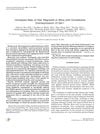TLDR Injecting specific oligonucleotides can change hair growth and structure by altering a gene.
The study investigated gene correction in keratinocytes by injecting chimeric RNA-DNA oligonucleotides (RDO) or single-stranded oligonucleotides (ssODN) into the skin of C57BL/6 mice to induce a mutation in the K17 gene. The results showed that 5 out of 7 mice injected with K17A-RDO and all 5 mice injected with K17A-ssODN exhibited twisted hair shafts, broken hair follicles, and occasional ruptures of hair bulbs, with a 50% reduction in full anagen hair follicles. Control injections without the mutation did not cause abnormalities. The study concluded that these oligonucleotides affected hair growth and morphology by successfully inducing the targeted mutation.
 April 2016 in “Chinese Journal of Dermatology”
April 2016 in “Chinese Journal of Dermatology” Wnt10b can help regenerate hair follicles.
 20 citations
,
December 2015 in “Journal of Pharmacopuncture”
20 citations
,
December 2015 in “Journal of Pharmacopuncture” Thread-embedding therapy helped hair grow back in mice and might do the same in humans.
 3 citations
,
March 2015 in “Biomolecules & Therapeutics”
3 citations
,
March 2015 in “Biomolecules & Therapeutics” Phospholipids from pig lungs can significantly promote hair growth.
 1 citations
,
January 2015 in “Genetics and Molecular Research”
1 citations
,
January 2015 in “Genetics and Molecular Research” Stopping S100A3 activity slows down hair growth in mice.
LhGH promotes hair growth and prevents hair loss in mice.
 6 citations
,
August 2007 in “Journal of Surgical Research”
6 citations
,
August 2007 in “Journal of Surgical Research” Mice genetically modified to produce more Del1 protein had faster hair regrowth.
 27 citations
,
May 2006 in “Biochemical and Biophysical Research Communications”
27 citations
,
May 2006 in “Biochemical and Biophysical Research Communications” Wnt-10b is important for starting hair growth and developing hair follicles.
January 2001 in “Acta Academiae Medicine Militaris Tertiae” K14 expression in young rats differs from adults.
31 citations
,
August 2000 in “Journal of Investigative Dermatology” Stem cells are key for hair follicle recovery.
107 citations
,
June 1997 in “PubMed” EGFR is essential for normal hair development and follicle differentiation.






